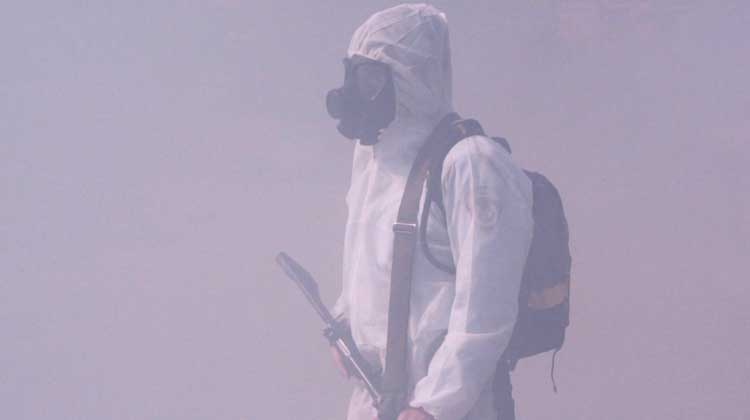
Administration officials said April 14 that the poison gas attack in Douma, Syria, April 8 was most likely a chlorine gas attack, with additional evidence pointing to the use of the nerve agent sarin.
Though the issue of chemical attacks is one that often strikes terror, particularly to vulnerable populations around the globe, what does a chemical attack actually mean? What happens? And what is the danger?
Exposure to a chlorine gas attack—depending on the concentration—can range from small irritations to death. According to Chlorine Gas: An Evolving Hazardous Material Threat and Unconventional Weapon, “At 1.3 parts per million (PPM), chlorine starts to cause irritation of the mucus membranes. Pulmonary symptoms begin at exposures greater than 15 PPM, and concentration s greater that 430 PPM are fatal within 30 minutes.”
CNN reported that many Syrian victims of the April 8 attack died in their hiding places, trying to escape bombardment.
“Many of the victims had been hiding in what appeared to be the basement of their homes to survive the shelling that has reduced this town, northeast of the capital Damascus, almost to rubble,” the report said.
A danger with chlorine gas is that it is heavier than air, so it lingers near the ground—a particular danger to those hiding in basements and below ground.
Officials also indicated that Syria employed sarin gas in the attack with a devastating and deadly impact. And it is suspected that Syria used a “sarin-like” agent in an attack in 2017. Sarin gas—or liquid—begins to take its toll almost immediately.
“Since sarin has no smell or taste, the person may very well have no idea what’s going on,” wrote James Hamblin in an article in The Atlantic in 2013. “Their chest tightens, vision blurs. If the exposure was great enough, that can progress to convulsions, paralysis, and death within 1 to 10 minutes.”
The history of chemical warfare is about a century old with the first use of chlorine gas occurring in April 1915, when Germans reportedly released 150 tons of gas killing scores of allied troops. Though the 1925 Geneva Protocol banned chemical weapon use in warfare it hasn’t completely stopped their use.
Hamblin also noted that a German scientist developed sarin—originally an insecticide—and the Nazis found more effective as a chemical weapon than chlorine.
“They did not use it in World War II, though,” Hamblin wrote, “reportedly because they understood its potential and feared retaliation in kind.” He noted, however, that Iraqis used sarin against the Kurds in 1988, as did the Tokyo subway attacker in 1995.
For a more in-depth look at the history of chemical warfare, check out Jonathan Tucker’s work War of Nerves: Chemical Warfare from World War I to Al Qaeda.
© 2018 Homeland411